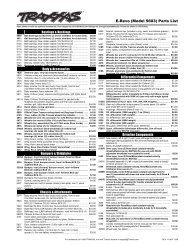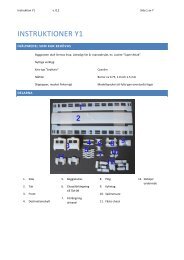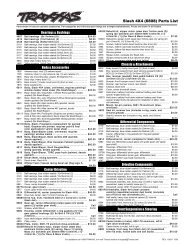ESU 51982 Manual Engelska
ESU 51982 Manual Engelska
ESU 51982 Manual Engelska
You also want an ePaper? Increase the reach of your titles
YUMPU automatically turns print PDFs into web optimized ePapers that Google loves.
Function Outputs<br />
12.3. Special Effects on Function Outputs<br />
12.3.1. Switching on Outputs and Different Options<br />
Each function output can / must be unlocked prior to using it.<br />
Furthermore, each output offers the choice of a lighting effect or<br />
can be additionally occupied with logical functions such as “Grade<br />
Crossing” or “High beam”.<br />
The following lighting effects are available:<br />
• Dimmable light: A normal continuous output. The brightness will<br />
be reduced to about 50% if the dimmer function is on.<br />
• Dimmable headlight with “fade in/out”: Here the output is<br />
switched on slowly and immitates the slow glowing of oil lamps or<br />
very old light bulbs. The brightness will be reduced to about 50%<br />
if the dimmer function is on.<br />
• Single Strobe: This is a single strobe light (short flashing) output.<br />
The frequency can be adjusted.<br />
• Double Strobe: This will result in two short flashes. The frequency<br />
can be adjusted.<br />
• Rotary Beacon: This effect should simulate a revolving reflector<br />
and bulb assignment of a very popular warning beacon atop many<br />
diesels of the 60’s and 70’s.<br />
• Prime Stratolight: This is the more modern version of the Rotary<br />
beacon.<br />
• Ditch Light Type1: The ditch light type 1 will revert to a steady On<br />
state when it is not flashing.<br />
• Ditch Light Type 2: The ditch light type 2 will revert to Off state<br />
when it is not flashing.<br />
• Blinklicht: This is the “classical” flashing light. The frequency can<br />
be adjusted.<br />
• Mars Light: This effect simulates the sweeping pattern of this wellknown<br />
warning beacon in the USA.<br />
• Gyra Light: The Gyra Light is similar to the Mars Light, but is slower<br />
in motion.<br />
• Coupler function: You can use this function to control Krois® or ROCO®<br />
couplers, also in connection with automatic pushing/removing.<br />
12.3.2. Adjusting the Lighting Effects<br />
The LokPilot V4.0 provides 3 CVs for each physical output, which<br />
defines their behavior.<br />
Mode Select: Defines which effect you want to have for the<br />
Brightness:<br />
output.<br />
Defines the brightness of each individual function<br />
output in 32 steps (0 to 31).<br />
Special functions: Defines some further modes for each function output.<br />
Have a look at the chart figure 14 to see how this works.<br />
The CV for special functions needs to be explained in more detail.<br />
The special functions are additional functions you could add to<br />
each output.<br />
Phase Select: Alters the timing of the effect so that it is 180<br />
degree out of phase with other effects. This allows<br />
you to create alternate blinking. It is used<br />
for ditch lights mainly.<br />
Grade Crossing: Causes the lighting effect to become active only<br />
when the global flag “Grade crossing enable” is<br />
set AND the corresponding function key is ON.<br />
Grade crossing logic can be used with any of the<br />
light effects. Grade Crossing can be used with<br />
most of the lighting effects.<br />
Rule 17 Forward: Applicable only if the output is set to either<br />
“Dimmable headlight” or “Dimmable headlight<br />
with fade in / out”. Causes the effect to be<br />
dimmed to around 60% of the set brightness, if<br />
the locomotive is stopped. When the engine is<br />
running forward, the output will be increased to<br />
a 100%.<br />
Rule 17 Reverse: Like Rule 17 Forward, but the brightness will be<br />
increased to a 100% when the locomotive drives<br />
backwards.<br />
Dimmer: Causes the output to be dimmed to around<br />
60% of the defined brightness, if the global flag<br />
“Dimmer” is set. With this function you are able<br />
to realise a full beam very easily by setting the the<br />
39












